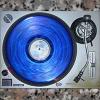Since this is a wall related question, I'll add it here.
Is there a master list of materials, or is everyone just adding as they go? I noticed JP's material list was much more than a stock table.
I made myself the materials list I use in my tables. I add more material as I need them, and I usually save them so I always have the latest list of materials for newer tables. I do not use all the materials in a table, usually just a few, but they are good to have is I should need any of them. Mostly they are different colors of plastics and rubbers, and the metal ones are mostly different kind of hard semi transparent plastics, and of course chrome metals for the wire ramps and similar objects. The top of my list consist of the physical materials, which I assign to all the objects that the ball may hit, plastic, rubbers, metals, wood. For example, I have a material called "Invisible", and I use that to make a target invisible in case that I need a custom target which do not exist in VPX. I make the target invisible using this material, then I can sync the movement of the target with the primitive with the new shape. And you may ask, why don't you make the target invisible in the properties window? Well, because the target will become automatically non collidable and I want the ball to hit the target 
Ahh, so after playing with this a little, the material is just settings from what I saw on your image. You're not using an image to make the material, right?
Yes, that's right. There a just a few materials that are meant to be used with an image:
Plastic, Plastic Dynamic, and their dark versions: I use that for all the plastics and targets that use an image. The Dynamic version has its transparency set to 0.9999 which makes the object not really transparent, but I use it is the lights needs to shine through, or the object is movable.
And other material that I use with an image is Toys and Toys Dynamic: It is the same as Plastic but it has a little more reflections, used mostly on primitives which are not flat, like a Smurf toy or an UFO.
All the other materials don't need an image.
Sometimes if I need to give a special color to an object, like the side walls on some cabinets, then I use the Plastic material and I cut a 32x32 image with the color I need. This is because the Plastic material doesn't change the images, and does not add any color or shade to them. I do this because sometimes it is not easy to get the right color using only a material.
The Metal materials work together with the environment image. In my tables I use an environment image called JPS_EnvBalanced, which I made by combining different environment images, to give the metals a really shiny metal look and get a balance in the shadows. Only one of tables uses an image with more shadows, this is the Serious Sam table, since the totem images don't look good with the normal one I use, and they need a little more shadows. To these idols I use a metal material to get some shadows on them, but with a lower Shinnies, and a simply stone wall image to give those idols a stone color. The Shinnies in the metal materials is used to blend more or less the environment image.
Here it is an image for comparison between the two environment images:

that was a little info about materials 
Edited by jpsalas, 24 May 2025 - 08:24 AM.






 Top
Top
























 are all trademarks of VPFORUMS.
are all trademarks of VPFORUMS.